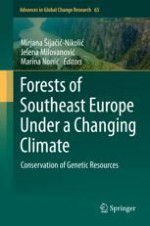2019 | OriginalPaper | Buchkapitel
6. State of Biodiversity and Forest Genetic Resources in Greece in Relation to Conservation
verfasst von : Filippos A. Aravanopoulos, Paraskevi G. Alizoti, Anna-Maria Farsakoglou, Ermioni Malliarou, Evangelia V. Avramidou, Nikolaos Tourvas
Erschienen in: Forests of Southeast Europe Under a Changing Climate
Aktivieren Sie unsere intelligente Suche, um passende Fachinhalte oder Patente zu finden.
Wählen Sie Textabschnitte aus um mit Künstlicher Intelligenz passenden Patente zu finden. powered by
Markieren Sie Textabschnitte, um KI-gestützt weitere passende Inhalte zu finden. powered by
